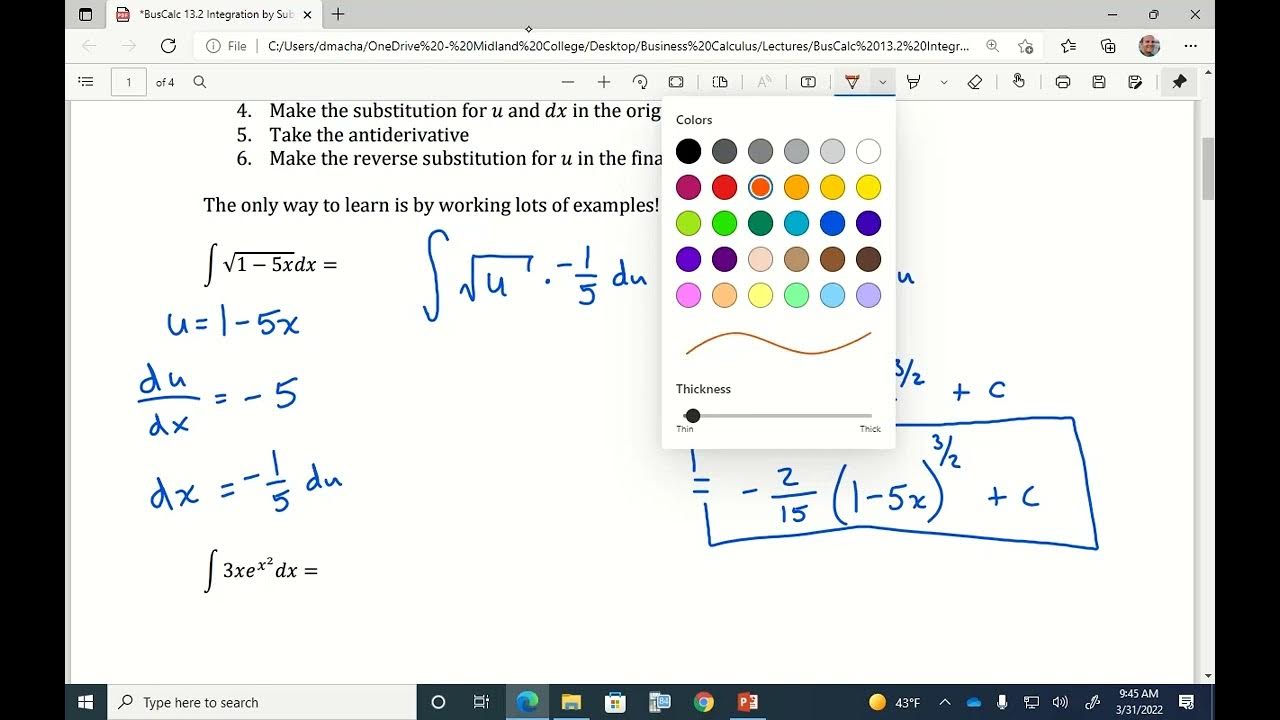What's an anti-derivative?
TLDRThe video script delves into the concept of antiderivatives, which are functions that reverse the process of differentiation. It begins with the power rule, illustrating that the derivative of x^3 is 3x^2, and then introduces the idea of an antiderivative, which when differentiated yields the original function. The script explains that antiderivatives are not unique and can include an infinite family of functions, such as x^3 plus any constant. The general antiderivative is represented as F(x) plus an arbitrary constant C. The video provides a method to find the antiderivative of a function, demonstrated through examples like x^n and sin(x), and emphasizes the importance of verification through differentiation. It concludes with the property that the antiderivative of a sum of functions is the sum of their antiderivatives, a property analogous to the derivative of a sum. The script encourages a 'guess and check' approach to find antiderivatives and hints at further exploration of this topic in future videos.
Takeaways
- 📚 The power rule states that the derivative of x^n is n*x^(n-1). When reversing this process, we find the antiderivative.
- 🔄 The antiderivative of a function is a function whose derivative equals the original function.
- 🔀 An antiderivative can be expressed as the original function plus an arbitrary constant (C).
- ➕ There are infinitely many antiderivatives for a given function, differing only by a constant.
- 📈 The general antiderivative of 3x^2 is x^3 + C, where C is an arbitrary constant.
- 🔢 For any function f(x), if F(x) is an antiderivative of f(x), then F(x) + C is also an antiderivative of f(x).
- 🤔 The process of finding antiderivatives often involves a bit of guess and check, based on the known derivatives of functions.
- 🧮 The general antiderivative of x^n is (x^(n+1))/(n+1) + C.
- 🔁 The antiderivative of the sum of two functions is the sum of their antiderivatives.
- ⏮ The derivative of a constant is zero, which is why constants are added when finding antiderivatives.
- 🔢 The antiderivative of sin(x) is -cos(x) + C, and similarly for other trigonometric functions.
- ⚖️ The antiderivative property extends to the sum rule, meaning the antiderivative of f(x) + g(x) is F(x) + G(x), where F and G are respective antiderivatives.
Q & A
What is the derivative of x cubed according to the power rule?
-The derivative of x cubed is 3x squared, which is found by bringing down the exponent (3) and reducing it by one for the new exponent.
What is an antiderivative?
-An antiderivative is a function that, when differentiated, yields the original function. It is the reverse process of taking a derivative.
How is the antiderivative of 3x squared related to x cubed?
-The antiderivative of 3x squared is x cubed because if you differentiate x cubed, you get 3x squared.
Why are there multiple antiderivatives for the same function?
-There are multiple antiderivatives for the same function because when you differentiate a constant, it becomes zero, and thus, adding any constant to an antiderivative does not change its derivative.
What is the general antiderivative of 3x squared?
-The general antiderivative of 3x squared is x cubed plus an arbitrary constant C, denoted as F(x) + C.
How can you determine the antiderivative of a function like x to the power of n?
-The antiderivative of x to the power of n is x to the power of n plus 1 divided by n plus 1, plus an arbitrary constant C.
What is the antiderivative of the sine function?
-The antiderivative of the sine function is the negative cosine function, written as -cos(x) plus an arbitrary constant C.
What property allows you to find the antiderivative of a sum of functions?
-The antiderivative of a sum of functions is the sum of the antiderivatives of the individual functions, which is a property known as the linearity of antiderivatives.
How does the process of finding an antiderivative involve guess and check?
-The process involves making an educated guess about the form of the antiderivative based on the behavior of derivatives, and then verifying the guess by differentiating it to see if it matches the original function.
Why is the constant term added in the general antiderivative formula?
-The constant term is added because the derivative of a constant is zero, so any constant added to an antiderivative will not affect the result when differentiating, thus ensuring the antiderivative is unique up to an arbitrary constant.
What is the significance of the general antiderivative formula in calculus?
-The general antiderivative formula is significant because it provides a systematic way to find antiderivatives of functions, which is essential for solving indefinite integrals and understanding the accumulation of quantities in calculus.
How does the script relate the concept of antiderivatives to the rules of differentiation?
-The script shows that antiderivatives are the inverse process of differentiation and that the rules of differentiation, such as the power rule and sum rule, have corresponding properties in the context of antiderivatives.
Outlines
📚 Understanding Antiderivatives and the Power Rule
This paragraph introduces the concept of antiderivatives, which are the reverse of derivatives. It explains that the antiderivative of 3x squared is x cubed, meaning that if you differentiate x cubed, you get back 3x squared. The general definition of an antiderivative is presented, stating that a function F is an antiderivative of another function f if the derivative of F equals f. The paragraph also discusses that there are infinitely many antiderivatives for a given function, differing only by a constant, and introduces the general antiderivative notation F(x) + C. The concept is further illustrated by finding the antiderivative of x to the power of n, which is shown to be (x to the power of n + 1) / (n + 1) + C, and verified by differentiating it to get back the original function.
🔍 Deriving the Antiderivative of Trigonometric Functions
The second paragraph delves into the antiderivative of trigonometric functions, specifically focusing on the sine function. It claims that the antiderivative of sine of x is minus cosine of x plus a constant C, which is verified by differentiating the proposed antiderivative and confirming that it equals the original function, sine of x. The paragraph also touches on the antiderivative property for the sum of functions, stating that the antiderivative of the sum of two functions is the sum of their antiderivatives. This is supported by the rule that the derivative of a sum is the sum of the derivatives, and it is shown that this property holds true for antiderivatives as well.
Mindmap
Keywords
💡Power Rule
💡Antiderivative
💡Derivative
💡General Antiderivative
💡Integration by Parts
💡Chain Rule
💡Scalar Multiple Rule
💡Sum Rule
💡Constant of Integration
💡Differentiation
💡Trigonometric Functions
Highlights
The derivative of x cubed is 3x squared using the power rule.
An antiderivative is a function whose derivative is the original function.
The antiderivative of 3x squared is x cubed plus a constant.
There are infinitely many antiderivatives for a given function, differing by a constant.
The general antiderivative is represented as F(x) + C, where C is an arbitrary constant.
The antiderivative of x to the power of n is (x to the power of n+1)/(n+1) + C.
The antiderivative can be found using a guess and check method by differentiating the proposed function.
The antiderivative of sine(x) is -cos(x) + C.
The antiderivative of a sum of functions is the sum of their antiderivatives.
The derivative of a sum of antiderivatives is equal to the sum of their derivatives.
The antiderivative property extends to the sum of functions, similar to the derivative property.
The process of finding antiderivatives often involves some trial and error using the reverse of derivative properties.
The power rule can be applied in reverse to find the antiderivative of a function.
The antiderivative of a constant times a function is the constant times the antiderivative of the function.
The antiderivative of a function is unique only up to an arbitrary constant.
The general antiderivative accounts for the constant of integration in indefinite integrals.
Differentiation and antidifferentiation are inverse operations, but antidifferentiation is not unique.
The process of finding antiderivatives involves understanding the reverse of common differentiation rules.
Transcripts
Browse More Related Video
5.0 / 5 (0 votes)
Thanks for rating:





